13.4 Anatomy of the Skeletal System
The skeleton system supports the body, facilitates movement with muscles, protects soft body parts, produces blood cells, and stores and releases calcium.[1] Muscles, movement and muscular disorders are discussed in the “Muscular System Terminology” chapter.
The skeletal system includes bones, joints, cartilages, and ligaments that support and give shape to the body. See Figure 13.1[2] for an illustration of the skeletal system. The skeletal system is subdivided into two major divisions called the axial skeleton and the appendicular skeleton. Each division is discussed in the following sections, along with related medical terms.
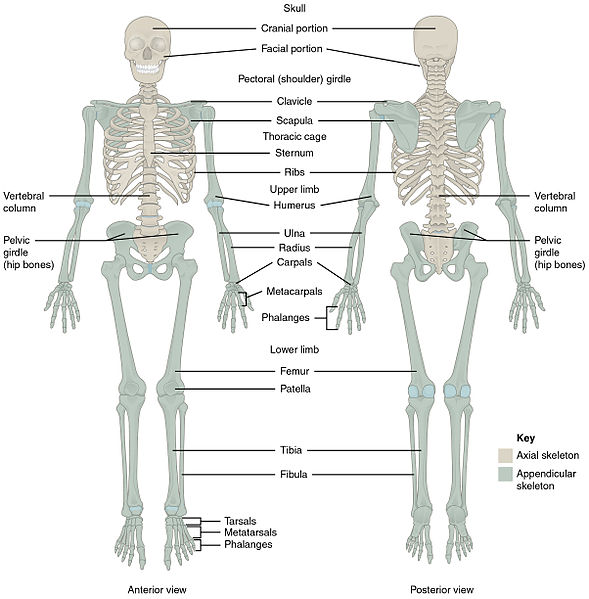
The Axial Skeleton
The axial skeleton forms the central axis of the body and includes the bones of the head, neck, chest, and back. It serves to protect the brain, spinal cord, heart, and lungs. It also serves as the attachment site for muscles that move the head, neck, back, shoulder, and hip joints. The axial skeleton includes the cranium, hyoid, vertebral column, and thoracic cage.[3]
Cranium
The cranium (KRĀ-nē-ŭm) is subdivided into the skull and the facial bones. It supports the face and protects the brain.[4] See Figure 13.2[5] for an illustration of the anterior bones of the skull and the face. A craniotomy (krā-nē-ŌT-ō-mē) refers to a surgical opening into the skull. A cranioplasty (KRĀ-nē-ō-plăs-tē) refers to surgical repair of the cranium.
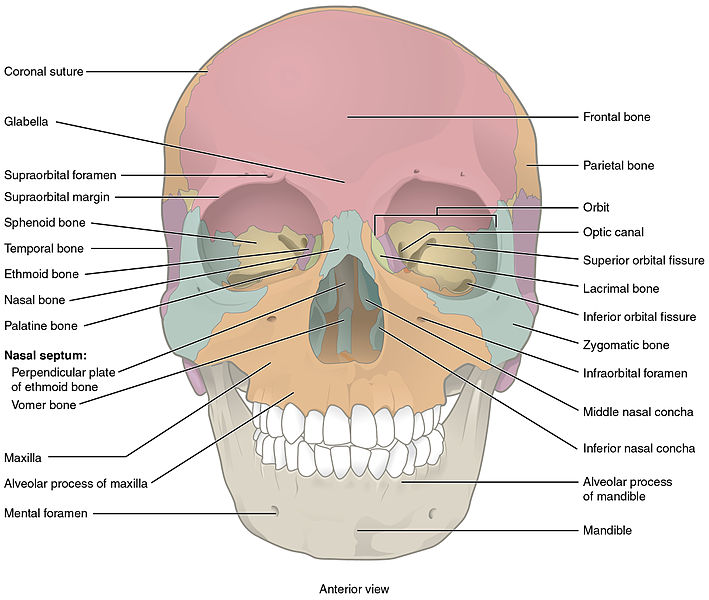
The major bones of the skull include the following[6]:
- Frontal (FRŬN-tăl): Forehead
- Parietal (pă-rī-ĔT-ăl): Upper lateral sides of the skull
- Temporal (TĔM-pō-răl): Lower lateral sides of the skull
- Sphenoid (SFĒ-noid): Posterior eye sockets and part of the base of the skull
- Ethmoid (ĔTH-moid): Part of the nose and base of the skull
- Occipital (ŏk-SĬP-ĭ-tăl): Posterior skull and base of the skull (See Figure 13.3[7] for an image of the occipital bone.)
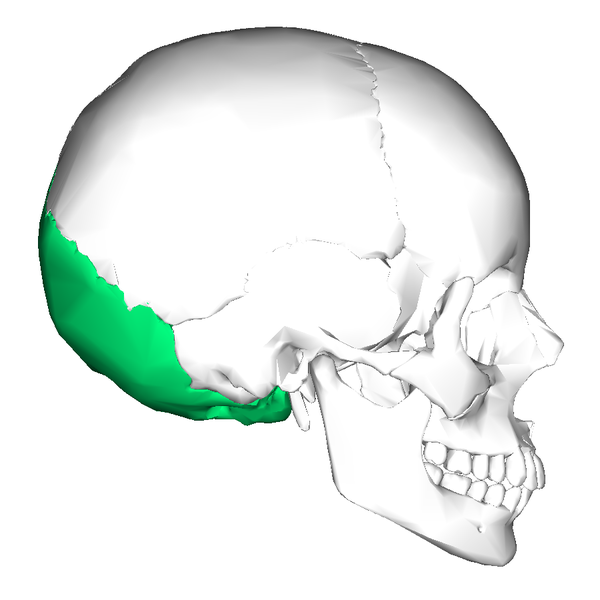
The facial bones form the upper and lower jaws, the nose, nasal cavity and nasal septum, and the orbit. The facial bones include 14 bones, with six paired bones and two unpaired bones. The paired bones are the maxillae, palatine, zygomatic, nasal, lacrimal, and inferior nasal conchae bones. The unpaired bones are the vomer and mandible bones[8]:
- Zygomatic (zī-gō-MĂT-ĭk): Pair of cheekbones
- Maxillary (MĂK-sĭ-lăr-ē): Upper jaw and hard palate
- Palatine (PĂL-ă-tīn): Pair of L-shaped bones between the maxilla and sphenoid that form the hard palate, walls of the nasal cavity, and the orbital floor of the eye
- Nasal (NĀ-zăl): Pair of bones that form the bridge of the nose
- Lacrimal (LĂK-rĭ-măl): Walls of the inner (medial) orbit (i.e., eye socket)
- Inferior conchae (ĬN-fēr-ē-ŏr KŎN-kē): Lower lateral walls of the nasal cavity
- Vomer (VŌ-mĕr): Bone that separates the left and right nasal cavity
- Mandible (MĂN-dĭ-bŭl): Lower jawbone and only movable bone of the skull
The temporomandibular joint (tĕm-pō-rō-MĂN-dĭ-bŭ-lăr) (TMJ) is a hinge joint between the temporal bone and the mandible that allows for the opening, closing, protrusion, retraction, and lateral movement of the lower jaw. Protrusion moves the mandible forward, and retraction pulls the mandible backward towards the neck.[9]
Hyoid
The hyoid (HĪ-oid) bone is an independent bone that does not contact any other bone and thus is not part of the skull. It is a small U-shaped bone located in the upper neck near the level of the inferior mandible, with the tips of the “U” pointing posteriorly. The hyoid serves as the base for the tongue above and is attached to the larynx and the pharynx below. Movements of the hyoid are coordinated with movements of the tongue, larynx, and pharynx during swallowing and speaking.[10] See Figure 13.4[11] for an illustration of the hyoid bone.
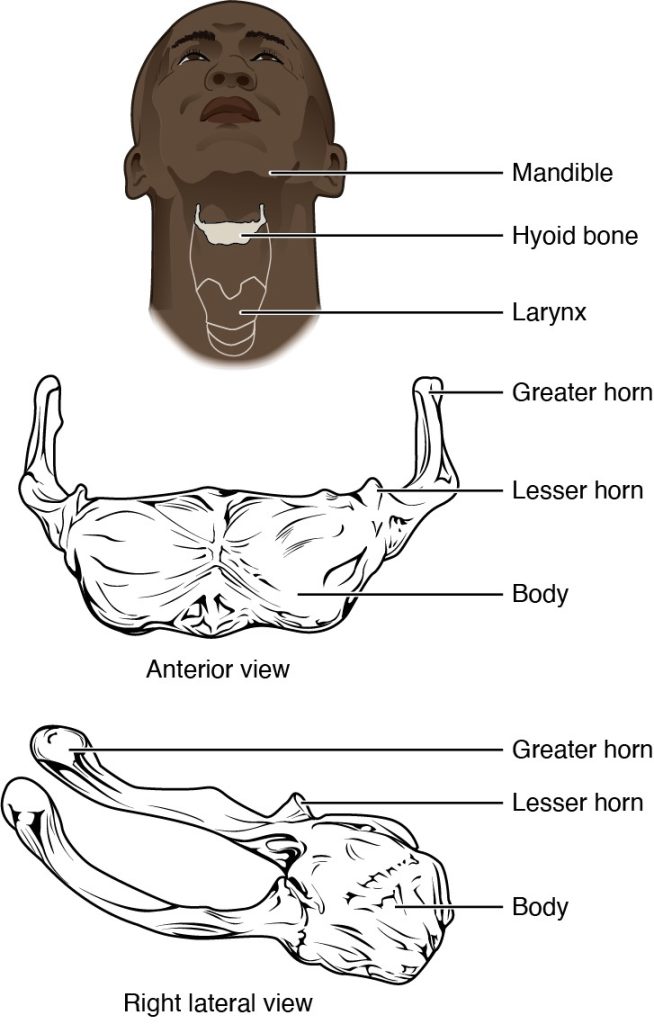
Vertebrae and Vertebral Column
The vertebral column consists of vertebrae (VŬR-tĭ-brā) that are separated by intervertebral disks (ĭn-tĕr-VĔRT-ĕ-brĕl dĭsks). The spinal cord runs through the center of the vertebrae. See Figure 13.5[12] for an illustration of the parts of a vertebra. Diskitis (dĭs-KĪ-tĭs) refers to inflammation of an intervertebral disk. A herniated disk (hûr-nē-Ā-tĭd dĭsk) refers to a condition in which a disk protrudes beyond the normal confines of the vertebrae. Spondylosis (spŏn-dĭ-LŌ-sĭs) is a painful condition of the spine resulting from the degeneration of the intervertebral disks. A diskectomy (dis-KEK-tŏ-mē) refers to excision of an intervertebral disk. A laminectomy (lăm-ĭ-NĔK-tō-mē) refers to excision of all or part of the lamina to ease pressure on the spinal cord or the nerve roots that may be caused by injury, herniated disk, narrowing of the spinal canal, or tumors. The lamina is the area of the vertebra where spinous and transverse processes connect.[13]
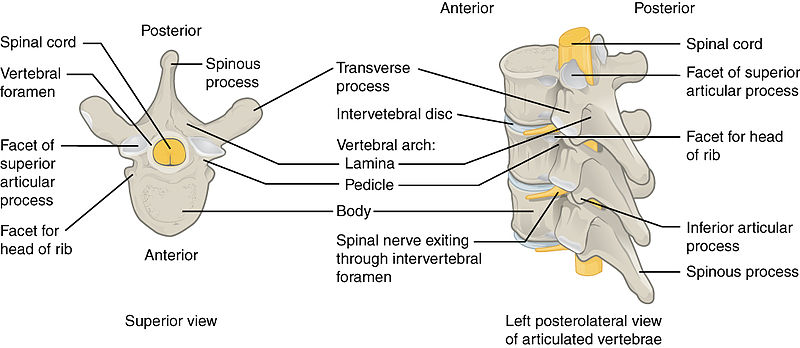
Together, the vertebrae and intervertebral disks form the vertebral column (vŭr-TĒ-brăl KŌL-ŭm), also known as the spinal column. It is a flexible column that supports the head, neck, and body and allows for their movements. It also protects the spinal cord, which passes down the back through the vertebral foramen.[14] View an illustration of the vertebral column in Figure 13.6.[15]
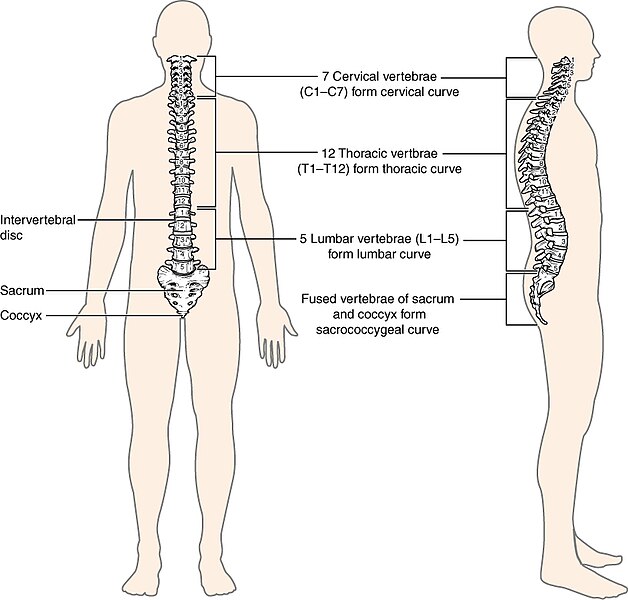
Vertebrae Regions
The vertebrae are divided into five regions called the cervical, thoracic, lumbar, sacrum, and coccyx[16]:
- Cervical (SŬR-vĭ-kăl): The first 7 vertebrae in the neck region, C1 to C7
- Thoracic (thō-RĂS-ĭk): The next 12 vertebrae that form the outward curvature of the spine, T1 to T12
- Lumbar (LŬM-bär): The next 5 vertebrae that form the inner curvature of spine, L1 to L5
- Sacrum (SĀ-krŭm): The triangular-shaped bone at the base of the spine, formed by the fusion of five sacral vertebrae, a process that does not begin until after the age of 20. See Figure 13.7[17] for an illustration of the sacrum.
- Coccyx (KŎK-sĭks): The tailbone, formed by the fusion of four very small coccygeal vertebrae. See Figure 13.8[18] for an illustration of the coccyx.
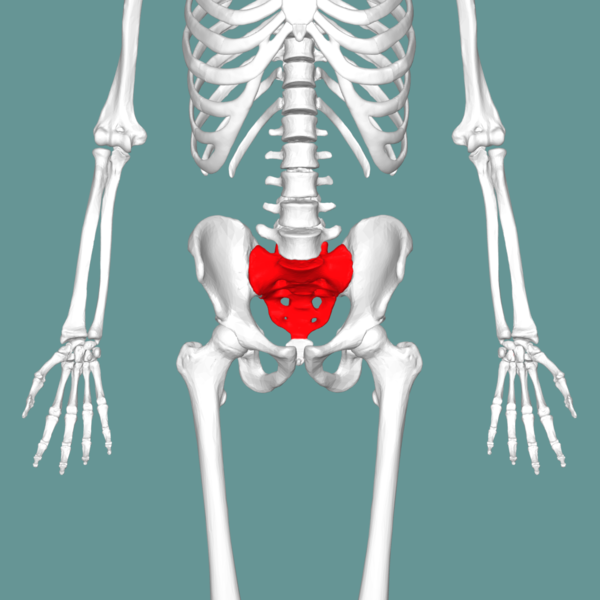
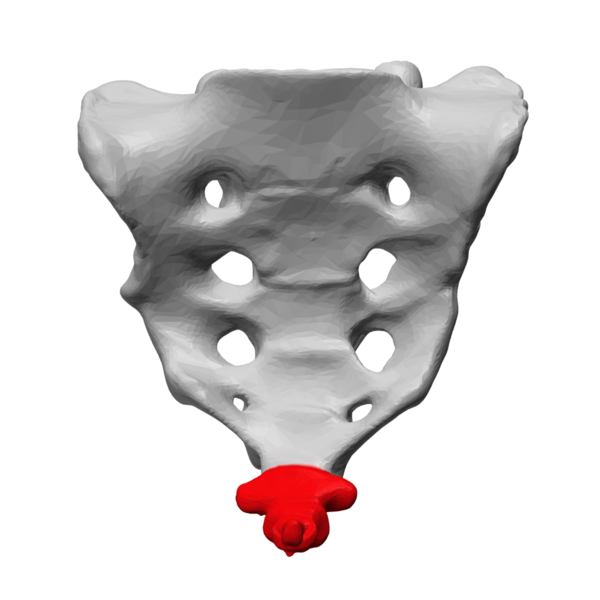
Vertebral Curvature
The vertebral column is normally curved, with two primary curvatures (thoracic and sacrococcygeal curves) and two secondary curvatures (cervical and lumbar curves).[19]
Thoracic Cage
The thoracic cage, commonly known as the rib cage, forms the chest (thorax). It consists of the sternum and 12 pairs of ribs, along with their costal cartilages. The ribs are anchored posteriorly to the 12 thoracic vertebrae (T1–T12). See Figure 13.9[20] for an illustration of the thoracic cage. The thoracic cage protects the heart and lungs.[21]
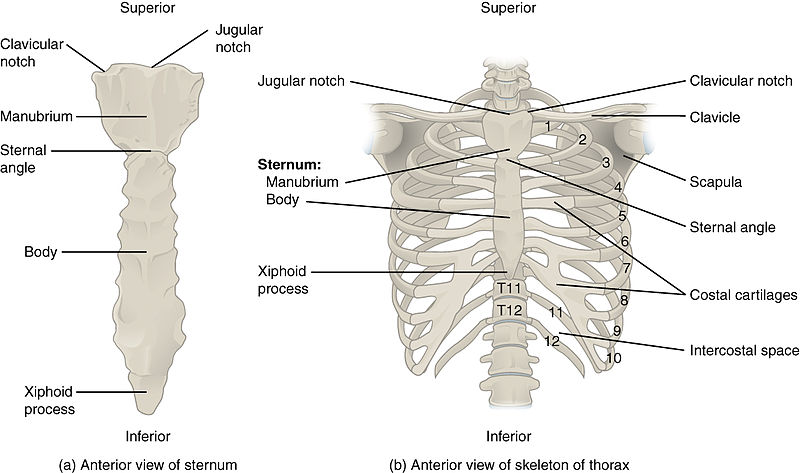
The sternum (STŬR-nŭm), also known as the breastbone, is divided into three parts[22]:
- Manubrium (mă-NŪ-brē-ŭm): The upper portion of the sternum
- Body (bŏd-ē): The middle portion of the sternum
- Xiphoid process (ZĪ-foid PRŌ-sĕs): The lower portion of the sternum made of cartilage
The 12 sets of ribs can be classified as true ribs, false ribs, and floating ribs[23]:
- True ribs (TRŌŌ rĭbz): Ribs 1-7 that are attached to the front of the sternum
- False ribs (FÔLS rĭbz): Ribs 8, 9, and 10 that are attached to the cartilage that joins the sternum
- Floating ribs (FLŌ-ă-tĭng rĭbz): Ribs 11 and 12 that are not attached to the front of the sternum
Intercostal (int-ĕr-KOS-tăl) means between the ribs. In clinical practice, intercostal retractions (ĭn-tĕr-KŎS-tăl rē-trăk-SHŏnz) may be observed in individuals experiencing labored breathing, where the muscles pull in between the ribs.
The Appendicular Skeleton
The appendicular skeleton includes the upper and lower limbs, plus the bones that attach each limb to the axial skeleton.[24]
Upper Limbs
The bones of the upper limbs include the bones of the arms, wrists, and hands. The shoulder attaches the upper limbs to the axial skeleton. See Figure 13.10[25] for an illustration of the upper limbs and pectoral girdle, the bony support of the shoulder consisting of the clavicle and scapula.[26]
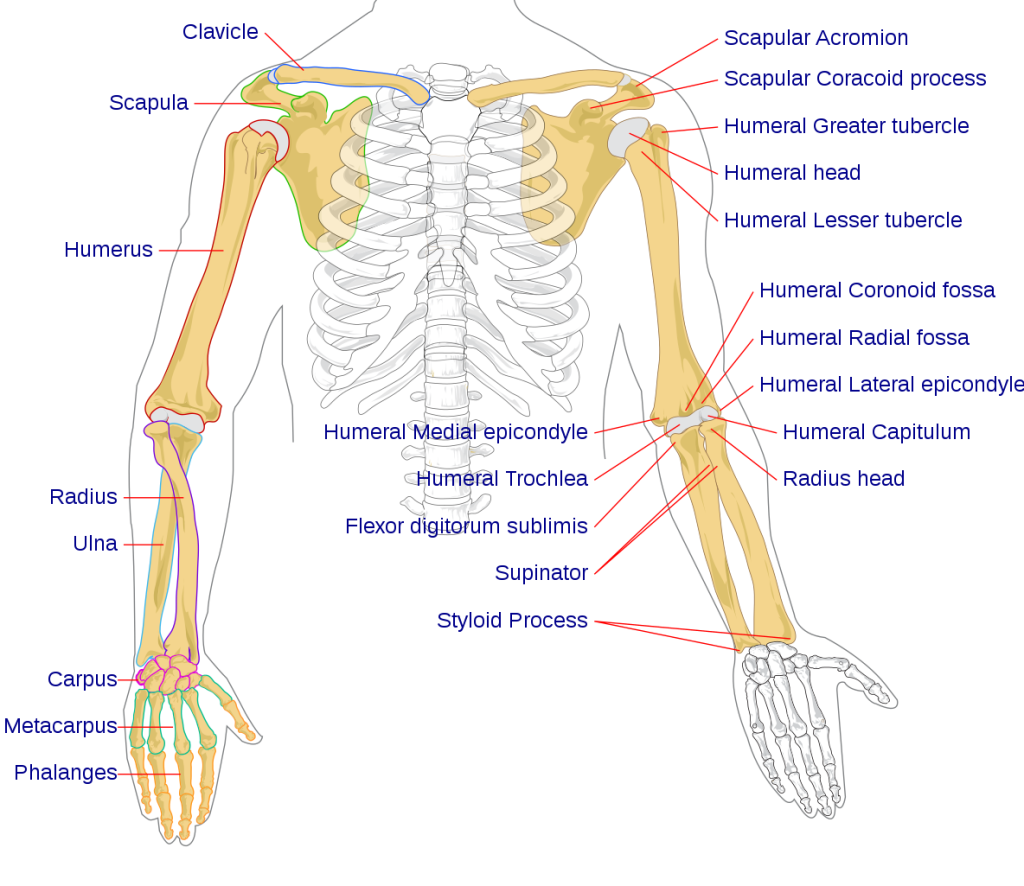
Arms
There are three bones in each arm[27]:
- Humerus (HYŌŌ-mĕr-ŭs): Upper arm
- Radius (RĀ-dē-ŭs): The thumb side of the forearm
- Ulna (ŬL-nă): The fifth finger side of the forearm
View a YouTube video[28] from UCDenver Anatomy Lab: Radius & Ulna
Wrists, Hands, and Fingers
See Figure 13.11[29] for an illustration of the bones of the wrist, hand, and fingers. The bones of the hand and wrist include the carpals, metacarpals, and phalanges[30]:
- Carpals (KĂR-pălz): Wrist bones
- Metacarpals (mĕt-ă-KĂR-pălz): Bones of the palm of hand
- Phalanges (fă-LĂN-jēz): Fingers (and toes)
A single finger is called a phalanx (FĂ-lăngks) and is composed of three bones called the distal phalanx, medial phalanx, and proximal phalanx. The exception is the thumb, which only has two bones, the distal and proximal.[31]
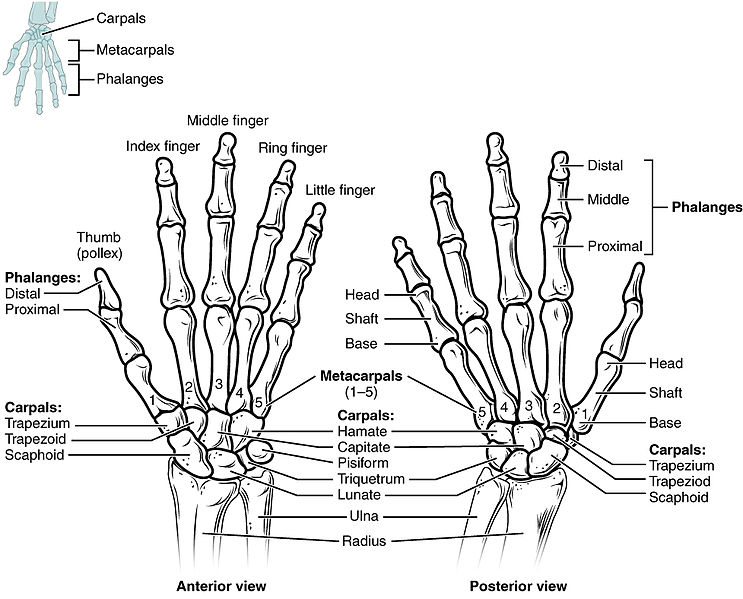
The Shoulder
Refer back to Figure 13.10 to view the bones of the shoulder that connect the arms to the axial skeleton to form the pectoral girdle and include the clavicle, scapula, and acromion[32]:
- Clavicle (KLĂV-ĭ-kŭl): Connect the sternum to the scapula, also known as the collarbone
- Scapula (SKĂP-yŭ-lă): Shoulder blade
- Acromion (ă-KRŌ-mē-ŏn): An extension from the scapula that forms the bony tip of the shoulder
Together, the clavicle, acromion, and spine of the scapula form a V-shaped bony line that provides for the attachment of neck and back muscles that act on the shoulder, as well as muscles that pass across the shoulder joint to act on the arm.[33]
Lower Limbs
The bones of the lower limb include bones of the leg and the feet. The hip attaches the lower limbs to the axial skeleton.
Leg
See Figure 13.12[34] for an illustration of the leg bones, including the femur, patella, tibia, and fibula[35]:
- Femur (FĒ-mŭr): Thigh bone, the longest and strongest bone in the human body
- Patella (pă-TĔL-ă): Kneecap
- Tibia (TĬB-ē-ă): The medial bone and main weight-bearing bone of the lower leg, commonly called the shin. The distal end of the tibia forms the medial malleolus (MĒ -dē-ăl MĂL-ē-ŏ-lŭs), which forms the bony protrusion on the medial side of the ankle.
- Fibula (FĬB-yŭ-lă): The smaller, lateral bone of the lower leg. The distal end of the fibula forms the lateral malleolus (LĂT-ĕr-ăl MĂL-ē-ŏ-lŭs), which forms the bony protrusion on the lateral side of the ankle.
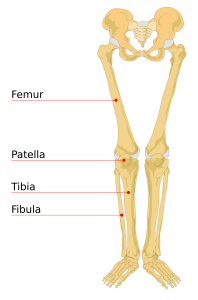
Feet
See Figure 13.13[36] for an illustration of the bones of the ankles and feet. There are several foot bones, but the major bones include the tarsals, metatarsals, phalanges, and calcaneus[37]:
- Tarsals (TĂR-sălz): Bones of the posterior half of the foot
- Metatarsals (mĕt-ă-TĂR-sălz): Bones of the anterior half of the foot
- Phalanges (fă-LĂN-jēz): Toes (and fingers). The hallux (HĂL-lŭks) is the great toe.
- Calcaneus (kăl-KĀ-nē-ŭs): Heel bone
Like the fingers, the toes are composed of three bones called the distal phalanx, medial phalanx, and proximal phalanx, with the exception of the great toe, which only has two bones, the distal and proximal.[38]
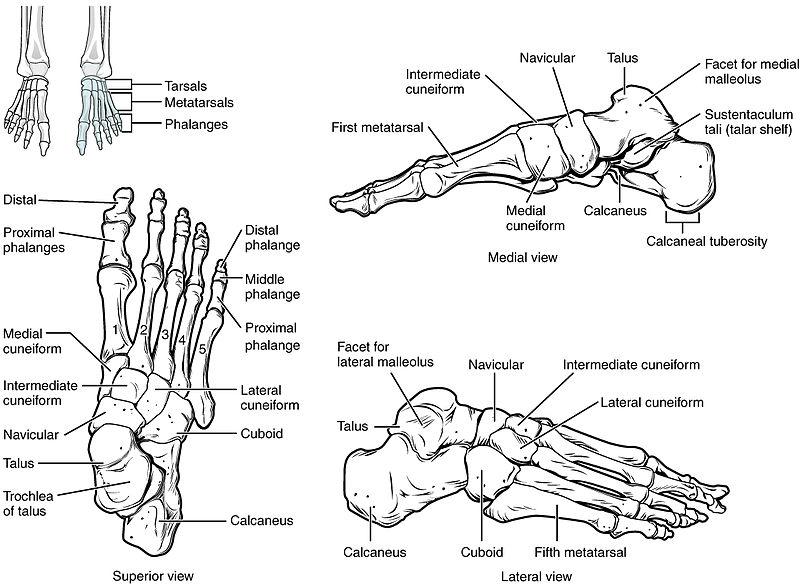
The Hip
The hip serves as the attachment point for each lower limb at the acetabulum (ăs-ĕ-TĂB-yŭ-lŭm), the large socket that holds the head of the femur. Each adult hip bone is formed by three separate pelvic bones, called the ilium, ischium, and pubis, that fuse together during the late teenage years.[39] See Figure 13.14[40] for an image of the hip and pelvis.
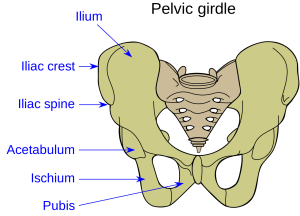
The ilium (ĬL-ē-ŭm) is the superior region that forms the largest part of the hip bone. It is attached to the sacrum at the sacroiliac joint. The ischium (ĬS-kē-ŭm) forms the posteroinferior region of each hip bone and supports the body when sitting. The pubis (PYŪ-bĭs) forms the anterior portion of the hip bone. The pubis curves medially, where it joins to the pubis of the opposite hip bone at a specialized joint called the pubic symphysis (PYŪ-bĭk SĬM-fĭ-sĭs). The pelvis (PĔL-vĭs) refers to the entire structure formed by the two hip bones, the sacrum, and the coccyx.[41] See Figure 13.15[42] for an illustration of the parts of the pelvis.
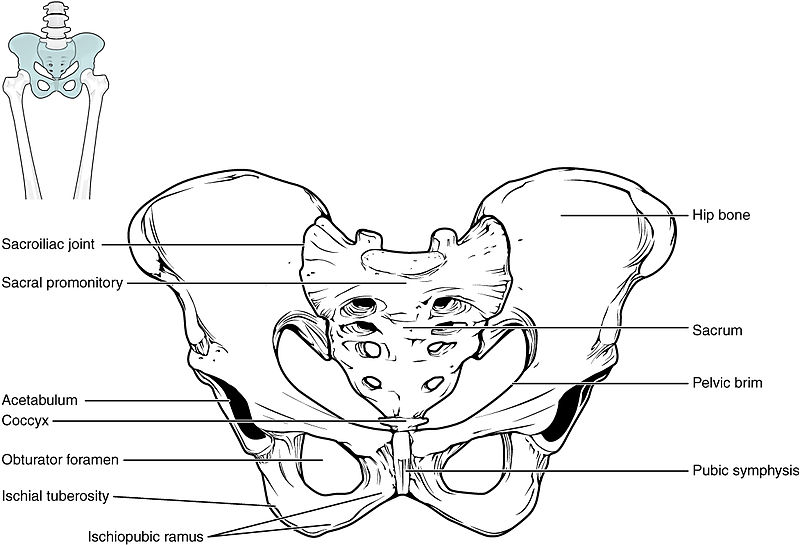
The shape of the pelvis is different for males and females. In general, the bones of the male pelvis are thicker and heavier because they have adapted to support a male’s typically heavier physical build. Because the female pelvis has adapted for childbirth, it is wider than the male pelvis. The shape and size of the pelvis can be used during forensic assessment to identify if skeletal remains are male or female.[43] See Figure 13.16[44] for a comparison of the female and male pelvis.
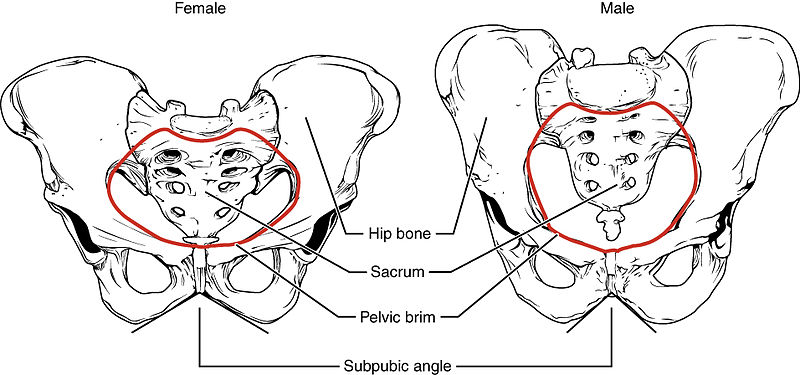
Joints
Joints (jōyntz), also called articulations, are places where two bones or bone and cartilage come together and form a connection. Dislocation (dĭs-lō-KĀ-shŏn) refers to displacement of a bone from its normal position in a joint. Joints are categorized based on their form and amount of movement and are referred to as fibrous joints, cartilaginous joints, or synovial joints.[45]
Fibrous Joints, Ligaments, and Tendons
Fibrous joints (FĪ-brŭs joints), also called synarthrosis or nonmoveable joints, occur when bones are attached by fibrous connective tissue. There are three types of fibrous joints: suture, gomphosis, and syndesmosis. A suture is the narrow fibrous joint found between most bones of the skull. A gomphosis is the narrow fibrous joint between the roots of a tooth and the bony socket in the jaw into which the tooth fits. A syndesmosis is a joint held together by a ligament, a type of connective tissue that connects bones.[46]
Other fibrous connective tissues in the musculoskeletal system include ligaments and tendons. Ligaments (LĬG-ă-mĕnts) are narrow bands of fibrous connective tissue that connect a bone to a bone. A tendon (TĔN-dŏn) is a fibrous connective tissue that attaches muscle to bone.[47] See Figure 13.17[48] for an image that compares ligaments and tendons.
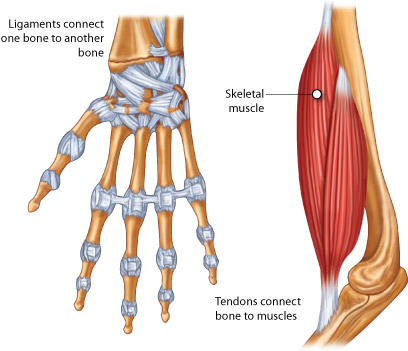
Cartilaginous Joints
Cartilaginous joints (kär-tĭ-LĂJ-ĭ-nŭs joints), also called amphiarthrosis or slightly moveable joints, occur when two bones are connected by cartilage (KĂR-tĭ-lĭj), a tough but flexible type of connective tissue. Examples of cartilaginous joints include the pubic synthesis and intervertebral disks.[49]
Synovial Joints
Synovial joints (sĭ-NŌ-vē-ăl joints), also called diarthroses or fully movable joints, have a fluid-filled space where two bones come together, called a joint cavity. Because the bones in a synovial joint are not directly connected to each other with fibrous connective tissue or cartilage, they are able to move freely against each other, allowing for increased joint mobility. Synovial joints are the most common type of joint in the body. A synovial membrane (sĭ-NŌ-vē-ăl MĔM-brān) is the lining or covering of synovial joints, and synovial fluid (sĭ-NŌ-vē-ăl FLŌŌ-id) is the lubricating fluid found between synovial joints. A synovectomy (sĭn-ō-VĔK-tō-mē) refers to excision of the synovial membrane.[50] See Figure 13.18[51] for an illustration of a synovial joint.
![]"Figure_38_03_03.jpg" by CNX OpenStax is licensed under CC BY 4.0 Illustration of synovial joint with labels for major parts](https://wtcs.pressbooks.pub/app/uploads/sites/46/2023/05/Figure_38_03_03.jpg)
Types of Synovial Joints
Synovial joints are categorized based on the shapes of the articulating surfaces of the bones that form each joint. The six types of synovial joints are pivot, hinge, condyloid, saddle, plane, and ball-and-socket joints.[52] See Figure 13.19[53] for an illustration of the various types of synovial joints.
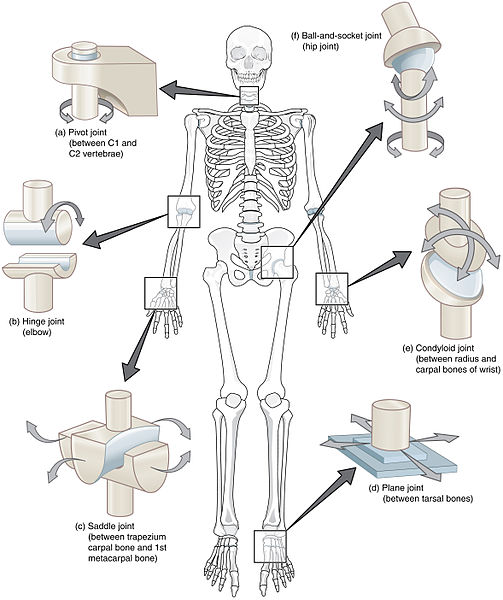
A few synovial joints of the body have a fibrocartilage structure located between the articulating bones called an articular disk or meniscus. Articular disks (är-TĬK-yŭ-lăr dĭsks) are generally small and oval-shaped whereas a meniscus (mĕ-NĬS-kŭs) is larger and C-shaped. For example, the knee connects the femur (upper leg bone) to the tibia (one of the lower leg bones) with a piece of fibrous cartilage called the meniscus. Meniscitis (men-ĭ-SĪT-ĭs) refers to inflammation of the meniscus. A meniscectomy (mĕn-ĭ-SĔK-tō-mē) refers to excision of the meniscus.
In addition to the meniscus, the knee also contains ligaments, tendons, and additional cartilage. Ligaments in the knee include the anterior cruciate ligament (ăn-TĪR-ē-ŏr KRŪ-shē-āt LĬG-ă-mĕnt) (ACL), lateral collateral ligament (LĂT-ĕr-ăl KŎL-ă-TĔR-ăl LĬG-ă-mĕnt) (LCL), medial collateral ligament (MĒ-dē-ăl KŎL-ă-TĔR-ăl LĬG-ă-mĕnt) (MCL), and posterior cruciate ligament (pŏs-TĪR-ē-ŏr KRŪ-shē-āt LĬG-ă-mĕnt) (PCL). See Figure 13.20[54] for an illustration of these structures in the knee joint.
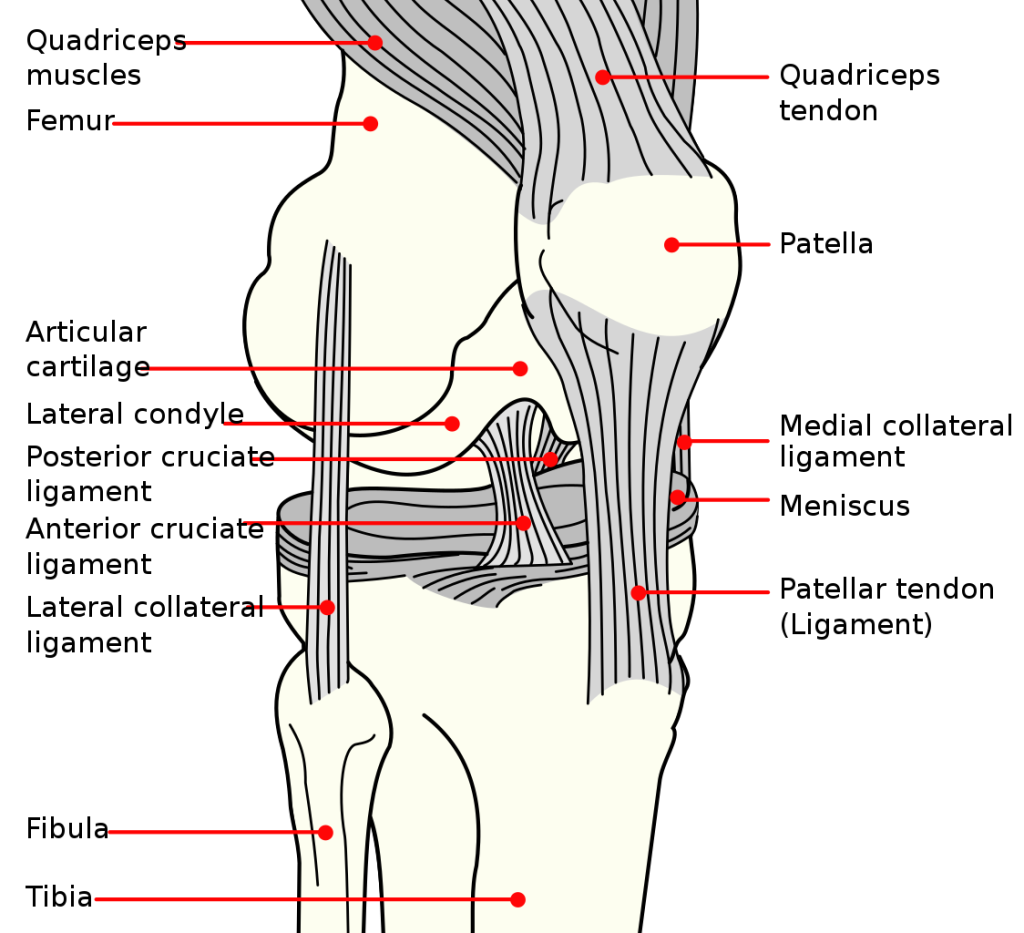
An additional structure located outside of a synovial joint is a bursa. A bursa (BŬR-să) is a thin connective tissue sac filled with lubricating fluid located in regions where skin, ligaments, muscles, or tendons rub against each other. Bursae are classified by their location. For example, a subcutaneous bursa is located between the skin and an underlying bone and allows skin to move smoothly over the bone.[55] Examples of a subcutaneous bursa are the suprapatellar bursa, prepatellar bursa, and infrapatellar bursa located in the knee, as seen in Figure 13.21.[56] Bursitis (bŭr-SĪ-tĭs) refers to inflammation of a bursa, typically one in the knee, elbow, or shoulder. Bursectomy (bŭr-SĔK-tō-mē) refers to excision of a bursa.
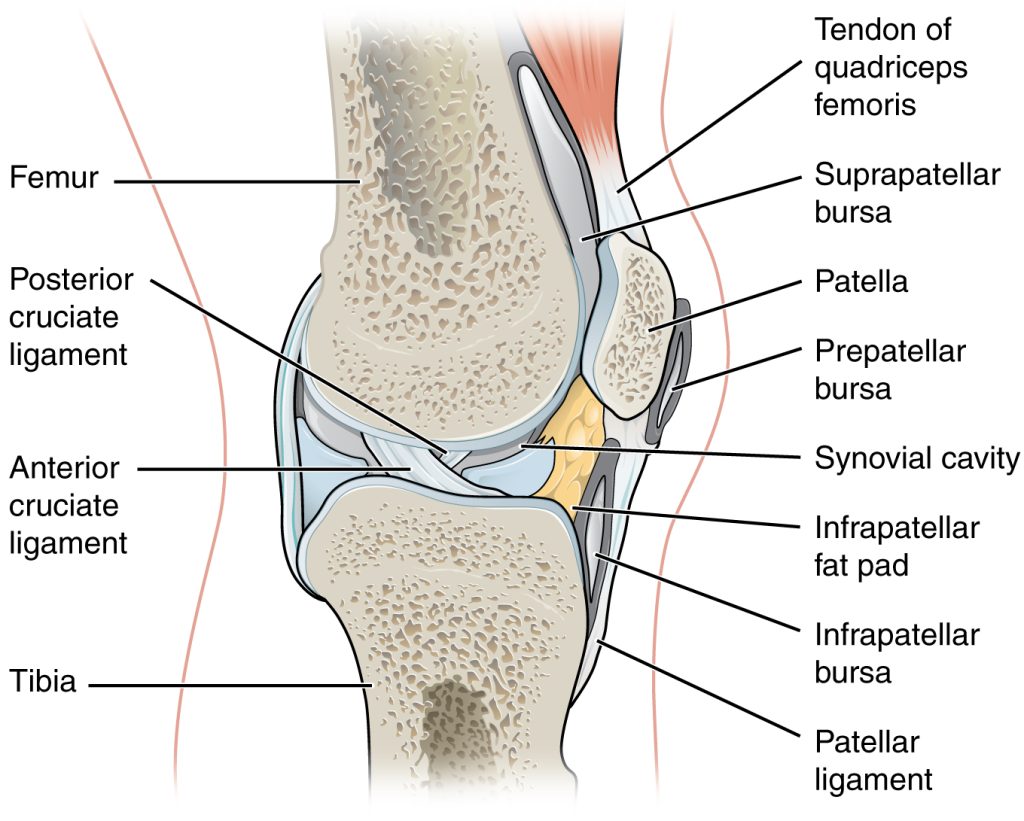
View a supplementary YouTube video[57] on joints: Joints: Crash Course Anatomy & Physiology #20
Bones
There are three types of cells related to the growth and breakdown of bone. Osteoblasts (OS-tē-ō-blastz) are bone-forming cells, and osteocytes (OS-tē-ŏ-sītz) are mature bone cells. The dynamic nature of bone means that new bone tissue is constantly being formed, and old, injured, or unnecessary bone is dissolved for repair or for calcium release. The cells responsible for bone breakdown are osteoclasts (ŏs-tē-ō-KLĀTZ). An equilibrium between osteoblasts and osteoclasts maintains healthy bone tissue.[58]
Bones contain more calcium (KĂL-sē-ŭm) (Ca+) than any other organ. When blood calcium levels decrease below normal levels, calcium is released from the bones by the osteoclasts so there is an adequate supply for metabolic needs. In contrast, when blood calcium levels are increased, excess calcium is stored in bone by the osteoblasts. This dynamic process of releasing and storing calcium goes on continuously.[59]
The bones of the skeletal system are comprised of an inner spongy tissue referred to as bone marrow. There are two types of bone marrow called red and yellow. Red bone marrow produces the red blood cells, white blood cells, and platelets. Yellow bone marrow contains adipose tissue, which can serve as a source of energy. Myeloma (mī-ĕ-LŌ-mă) is a type of cancer that forms in the bone marrow.[60]
There are several medical terms related to bones:
-
- Osteomalacia (ŏs-tē-ō-mă-LĀ-sē-ă) refers to the softening of bone.
- Osteomyelitis (os-tē-ō-mī-ĕ-LĪT-ĭs) refers to the inflammation of bone and bone marrow.
- Osteonecrosis (os-tē-ō-nĕ-KRŌ-sĭs) refers to bone death due to lack of adequate blood supply.
- Osteosarcoma (ŏs-tē-ō-săr-KŌ-mă) refers to a malignant tumor of bone.
- Osteopenia (os-tē-ō-PĒ-nē-ă) refers to abnormal reduction of bone mass.
- Osteoporosis (ŏs-tē-ō-pō-RŌ-sĭs) refers to a medical condition in which bones become weak, brittle, and prone to fractures.
Read more information about osteopenia and osteoporosis in the “Diseases and Disorders of the Skeletal System” section.
Review additional information about bone marrow and the production of red blood cells, white blood cells, and platelets in the “Anatomy of the Hematology System” in the “Blood Terminology” chapter.
- National Cancer Institute. (n.d.). Introduction to the skeletal system. National Institutes of Health. https://training.seer.cancer.gov/anatomy/skeletal ↵
- “701_Axial_Skeleton-01.jpg” by OpenStax College is licensed under CC BY 3.0 ↵
- This work is a derivative of Anatomy & Physiology by OpenStax and is licensed under CC BY 4.0. Access for free at https://openstax.org/details/books/anatomy-and-physiology-2e ↵
- This work is a derivative of Anatomy and Physiology by OpenStax licensed under CC BY 4.0. Access for free at https://openstax.org/books/anatomy-and-physiology/pages/1-introduction ↵
- “704_Skull-01.jpg” by OpenStax College is licensed under CC BY 3.0 ↵
- This work is a derivative of Anatomy and Physiology by OpenStax licensed under CC BY 4.0. Access for free at https://openstax.org/books/anatomy-and-physiology/pages/1-introduction ↵
- “Occipital_bone_lateral.png” by Anatomography is licensed under CC BY-SA 2.1 Japan ↵
- This work is a derivative of Anatomy and Physiology by OpenStax licensed under CC BY 4.0. Access for free at https://openstax.org/books/anatomy-and-physiology/pages/1-introduction ↵
- This work is a derivative of Anatomy and Physiology by OpenStax licensed under CC BY 4.0. Access for free at https://openstax.org/books/anatomy-and-physiology/pages/1-introduction ↵
- This work is a derivative of Anatomy and Physiology by OpenStax licensed under CC BY 4.0. Access for free at https://openstax.org/books/anatomy-and-physiology/pages/1-introduction ↵
- “Hyoid_bone_jpg” by Betts, et al. is licensed under CC BY 4.0. Access for free at https://openstax.org/details/books/anatomy-and-physiology-2e ↵
- “718_Vertebra.jpg” by OpenStax College is licensed under CC BY 3.0 ↵
- This work is a derivative of Anatomy and Physiology by OpenStax licensed under CC BY 4.0. Access for free at https://openstax.org/books/anatomy-and-physiology/pages/1-introduction ↵
- This work is a derivative of Anatomy and Physiology by OpenStax licensed under CC BY 4.0. Access for free at https://openstax.org/books/anatomy-and-physiology/pages/1-introduction ↵
- “715_Vertebral_Column.jpg” by OpenStax College is licensed under CC BY 3.0 ↵
- This work is a derivative of Anatomy and Physiology by OpenStax licensed under CC BY 4.0. Access for free at https://openstax.org/books/anatomy-and-physiology/pages/1-introduction ↵
- “Sacrum_-_anterior_view02.png” by BodyParts3D is made by DBCLS is licensed under CC BY-SA 2.1 Japan ↵
- “Coccyx_-_anterior_view01.png” by BodyParts3D is made by DBCLS is licensed under CC BY-SA 2.1 Japan ↵
- This work is a derivative of Anatomy and Physiology by OpenStax licensed under CC BY 4.0. Access for free at https://openstax.org/books/anatomy-and-physiology/pages/1-introduction ↵
- “721_Rib_Cage.jpg” by OpenStax College is licensed under CC BY 3.0 ↵
- This work is a derivative of Anatomy and Physiology by OpenStax licensed under CC BY 4.0. Access for free at https://openstax.org/books/anatomy-and-physiology/pages/1-introduction ↵
- This work is a derivative of Anatomy and Physiology by OpenStax licensed under CC BY 4.0. Access for free at https://openstax.org/books/anatomy-and-physiology/pages/1-introduction ↵
- This work is a derivative of Anatomy and Physiology by OpenStax licensed under CC BY 4.0. Access for free at https://openstax.org/books/anatomy-and-physiology/pages/1-introduction ↵
- This work is a derivative of Anatomy & Physiology by OpenStax and is licensed under CC BY 4.0. Access for free at https://openstax.org/details/books/anatomy-and-physiology-2e ↵
- “Human_arm_bones_diagram.svg” by LadyofHats Mariana Ruiz Villarreal is licensed in the Public Domain. ↵
- This work is a derivative of Anatomy and Physiology by OpenStax licensed under CC BY 4.0. Access for free at https://openstax.org/books/anatomy-and-physiology/pages/1-introduction ↵
- This work is a derivative of Anatomy and Physiology by OpenStax licensed under CC BY 4.0. Access for free at https://openstax.org/books/anatomy-and-physiology/pages/1-introduction ↵
- UCDenver Anatomy Lab 3244. (2013, August 31).Radius & Ulna. [Video]. YouTube. All rights reserved. https://www.youtube.com/watch?v=ThmvWFvHOmI ↵
- “806_Hand_and_Wrist.jpg” by OpenStax College is licensed under CC BY 3.0 ↵
- This work is a derivative of Anatomy and Physiology by OpenStax licensed under CC BY 4.0. Access for free at https://openstax.org/books/anatomy-and-physiology/pages/1-introduction ↵
- This work is a derivative of Anatomy and Physiology by OpenStax licensed under CC BY 4.0. Access for free at https://openstax.org/books/anatomy-and-physiology/pages/1-introduction ↵
- This work is a derivative of Anatomy and Physiology by OpenStax licensed under CC BY 4.0. Access for free at https://openstax.org/books/anatomy-and-physiology/pages/1-introduction ↵
- This work is a derivative of Anatomy and Physiology by OpenStax licensed under CC BY 4.0. Access for free at https://openstax.org/books/anatomy-and-physiology/pages/1-introduction ↵
- “Human_leg_bones_labeled.svg” is a derivative work by Jecowa at English Wikipedia and is licensed in the Public Domain. ↵
- This work is a derivative of Anatomy and Physiology by OpenStax licensed under CC BY 4.0. Access for free at https://openstax.org/books/anatomy-and-physiology/pages/1-introduction ↵
- “812_Bones_of_the_Foot.jpg” by OpenStax College is licensed under CC BY 3.0 ↵
- This work is a derivative of Anatomy and Physiology by OpenStax licensed under CC BY 4.0. Access for free at https://openstax.org/books/anatomy-and-physiology/pages/1-introduction ↵
- This work is a derivative of Anatomy and Physiology by OpenStax licensed under CC BY 4.0. Access for free at https://openstax.org/books/anatomy-and-physiology/pages/1-introduction ↵
- This work is a derivative of Anatomy and Physiology by OpenStax licensed under CC BY 4.0. Access for free at https://openstax.org/books/anatomy-and-physiology/pages/1-introduction ↵
- “Pelvic_girdle_illustration.svg” by U.S. National Cancer Institute is licensed under CC BY-SA 4.0 ↵
- This work is a derivative of Anatomy and Physiology by OpenStax licensed under CC BY 4.0. Access for free at https://openstax.org/books/anatomy-and-physiology/pages/1-introduction ↵
- “807_Pelvis.jpg” by OpenStax College is licensed under CC BY 3.0 ↵
- This work is a derivative of Anatomy and Physiology by OpenStax licensed under CC BY 4.0. Access for free at https://openstax.org/books/anatomy-and-physiology/pages/1-introduction ↵
- “809_Male_Female_Pelvic_Girdle.jpg” by OpenStax College is licensed under CC BY 3.0 ↵
- This work is a derivative of Anatomy and Physiology by OpenStax licensed under CC BY 4.0. Access for free at https://openstax.org/books/anatomy-and-physiology/pages/1-introduction ↵
- This work is a derivative of Anatomy and Physiology by OpenStax licensed under CC BY 4.0. Access for free at https://openstax.org/books/anatomy-and-physiology/pages/1-introduction ↵
- This work is a derivative of Anatomy and Physiology by OpenStax licensed under CC BY 4.0. Access for free at https://openstax.org/books/anatomy-and-physiology/pages/1-introduction ↵
- “tendon-lig.jpg” by unknown author is licensed under CC BY-SA 4.0. Access for free at https://pressbooks.ccconline.org/bio106 ↵
- This work is a derivative of Anatomy and Physiology by OpenStax licensed under CC BY 4.0. Access for free at https://openstax.org/books/anatomy-and-physiology/pages/1-introduction ↵
- This work is a derivative of Anatomy and Physiology by OpenStax licensed under CC BY 4.0. Access for free at https://openstax.org/books/anatomy-and-physiology/pages/1-introduction ↵
- “Figure_38_03_03.jpg” by CNX OpenStax is licensed under CC BY 4.0 ↵
- This work is a derivative of Anatomy and Physiology by OpenStax licensed under CC BY 4.0. Access for free at https://openstax.org/books/anatomy-and-physiology/pages/1-introduction ↵
- “909_Types_of_Synovial_Joints.jpg” by OpenStax College is licensed under CC BY 3.0 ↵
- “Knee_diagram.svg” by Mysid is licensed in the Public Domain. ↵
- This work is a derivative of Anatomy and Physiology by OpenStax licensed under CC BY 4.0. Access for free at https://openstax.org/books/anatomy-and-physiology/pages/1-introduction ↵
- “908_Bursa.jpg” by OpenStax College is licensed under CC BY 3.0 ↵
- CrashCourse. (2015, May 26). Joints: Crash Course Anatomy & Physiology #20 [Video]. YouTube. All rights reserved. https://www.youtube.com/watch?v=DLxYDoN634c ↵
- This work is a derivative of Anatomy and Physiology by OpenStax licensed under CC BY 4.0. Access for free at https://openstax.org/books/anatomy-and-physiology/pages/1-introduction ↵
- This work is a derivative of Anatomy and Physiology by OpenStax licensed under CC BY 4.0. Access for free at https://openstax.org/books/anatomy-and-physiology/pages/1-introduction ↵
- This work is a derivative of Anatomy and Physiology by OpenStax licensed under CC BY 4.0. Access for free at https://openstax.org/books/anatomy-and-physiology/pages/1-introduction ↵

